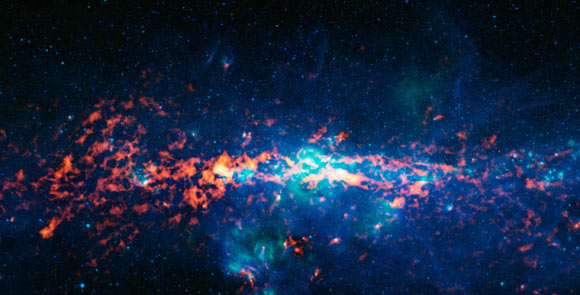Propionamide (C2H5CONH2), a complex alkyl amide with twelve atoms, is the largest peptide-like molecule detected in space, according to a new study led by Dr. Juan Li from Shanghai Astronomical Observatory and the Chinese Academy of Sciences.

Sagittarius B2 is a giant molecular cloud of gas and dust that is located about 390 light-years from the center of the Milky Way Galaxy. Sagittarius B2 is the bright orange-red region to the middle left of the image, which is centered on the Galactic center. Image credit: ESO / APEX / MSX / IPAC / NASA.
“Proteins, as the building blocks of living cells, are an essential component of living systems on Earth,” Dr. Li and his colleagues from China, Japan, France, Germany, the United States and Ukraine wrote in their paper.
“Proteins are polymers of amino acids joined together by the peptide bond, -NHCO-.”
“Due to the high molecular weight and extremely low gas-phase abundance, detection of proteins in the interstellar medium at the current stage of development of observation facilities looks like a formidable task.”
“Therefore, molecules with peptide-like bonds are of particular interest for our understanding of possible routes of protein formation in space.”
In their study, the astronomers focused on the giant molecular cloud complex Sagittarius B2 (Sgr B2).
“Sgr B2 is the massive star-forming region located close to the Galactic center,” they wrote.
“It has been found to be one of the best hunting grounds for complex organic molecules in the interstellar medium.”
“Many prebiotic molecules have been detected in this source, such as the branched molecule i-C3H7CN and the chiral molecule CH3CHCH2O.”
“Sgr B2 contains two main sites of star formation, Sgr B2(N) and Sgr B2(M), both of which host several dense, compact, hot cores.”
They analyzed spectra of Sgr B2 obtained with the Institut de Radioastronomie Millimetrique (IRAM) 30-m telescope on Pica Veleta, Spain.
They also used the archival interferometric data from the ReMoCA (Re-exploring Molecular Complexity with ALMA) survey.
“Our results provide strong evidence for warm, compact propionamide with high abundance in the hot cores of the Sgr B2 cloud complex,” the researchers wrote.
“From a chemical perspective, the presence of propionamide is not surprising.”
“As a substituted acetamide and the third member of the amide chemical family, propionamide is likely to have formation mechanisms that are similar to or associated with those of the two smaller amides: formamide and acetamide.”
“This detection suggests that large peptide-like molecules can form and survive during star-forming process and may form more complex molecules in the interstellar medium.”
A paper on the findings will be published in the Astrophysical Journal.
_____
Juan Li et al. 2021. Propionamide (C2H5CONH2): The largest peptide-like molecule in space. ApJ, in press; arXiv: 2108.05001







